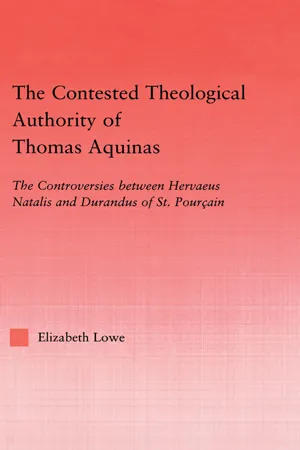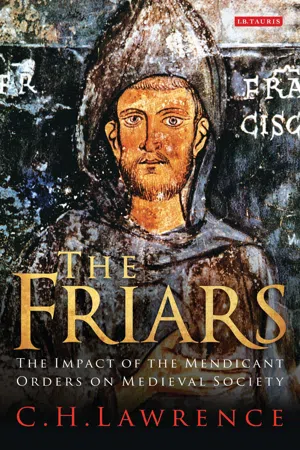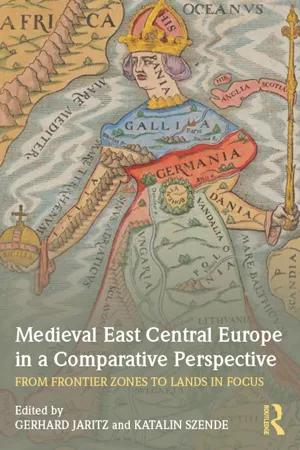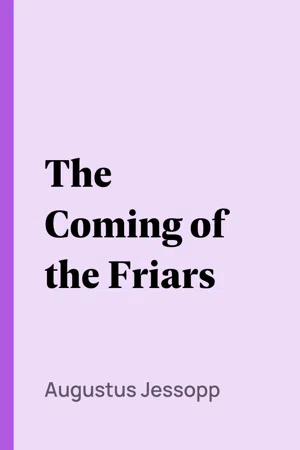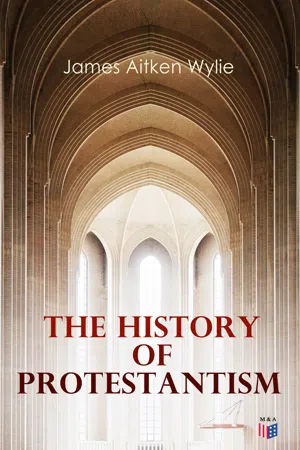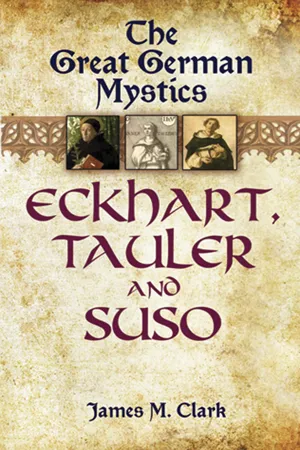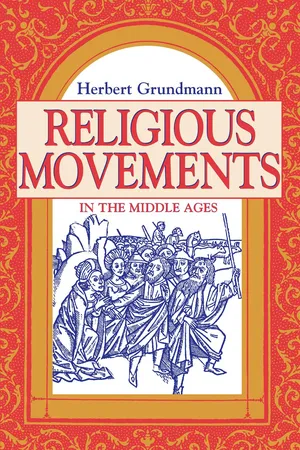History
Dominicans and Franciscans
Dominicans and Franciscans were two prominent mendicant orders within the Catholic Church during the Middle Ages. Founded by Saint Dominic and Saint Francis of Assisi, respectively, the Dominicans focused on preaching and education, while the Franciscans emphasized poverty and service to the poor. Both orders played significant roles in the religious, intellectual, and social developments of the medieval period.
Written by Perlego with AI-assistance
Related key terms
8 Key excerpts on "Dominicans and Franciscans"
- eBook - ePub
The Contested Theological Authority of Thomas Aquinas
The Controversies Between Hervaeus Natalis and Durandus of St. Pourcain, 1307-1323
- Elizabeth Lowe(Author)
- 2014(Publication Date)
- Routledge(Publisher)
The two-fold task which faced the incipient Order during the formative years in Toulouse was the conversion of heretics and the re-enforcement of the faith of the catholic minority. In pursuing this goal, Dominic and his followers preached sermons, debated with the Catharist perfecti, wrote tracts, engaged in apologetics and instructed their audiences on the articles of faith and the sacraments. 27 The intellectual dimension of these activities is striking and not only provides a sharp contrast to the verbal exhortations which characterized the preaching of most evangelical movements of the time, but reveals the predominant instructive aspect of the Dominican concept of preaching. 28 In the thirteenth and fourteenth centuries, the Dominicans would play a major role in transforming the art of preaching. 29 These same circumstances also served to differentiate the Order of Preachers from other evangelical movements of the time. First, in contrast to the lay origins of the Waldensians and the Franciscans, the Dominicans were from the outset a clerical order whose members saw themselves as operating well within the established framework of the ecclesiastical establishment - eBook - ePub
The Friars
The Impact of the Mendicant Orders on Medieval Society
- C.H. Lawrence(Author)
- 2013(Publication Date)
- I.B. Tauris(Publisher)
Chapter 4ST DOMINIC AND THE ORDER OF FRIARS PREACHERS
The Friars Preachers or Black Friars differed from the early Friars Minor both in their spirit and the circumstances of their origin. Their institution was the creation of two men of genius – the Spaniard, Dominic of Caleruega, and the German, Jordan of Saxony. From the start they were a clerical and learned order, a stepchild of the canons regular, to whom their founder belonged; and while they devoted themselves to an active apostolate in the street and market place, they retained many features of monastic observance. This mark of their monastic parentage was visibly indicated by the dress that gave them their popular name: a black cloak worn over the white habit and scapular of the Premonstratensian canons. Their fraternity sprang from the pastoral demands of the south of France, the Languedoc, where the ascendancy of the orthodox Church was threatened by the entrenched counter-church of the Catharist heretics. It was St Dominic’s preaching mission to combat the Cathars that gave birth to the new order.. . . THE EARLY CAREER OF ST DOMINIC
Dominic was a Castilian priest, probably of aristocratic birth – a late medieval tradition connects him with the noble family of Guzman, which owned property at Caleruega, his birth-place. He had been educated as a clerk in the schools of Palencia, and as a young man he had been given a canonry in the cathedral of Osma. At the time he joined it, the chapter of Osma had only recently been reconstituted as a community of canons regular living according to the Rule of St Augustine. The canons regular were a hybrid order of clerical monks. They had come into existence during the eleventh century in response to the propaganda of the reform party, which exhorted the secular clergy to live in communities on the model of the early apostolic Church. Their houses embraced a wide variety of observance, but all their customaries provided for a monastic regime based upon the renunciation of personal property and a community life of shared refectory and dormitory, organised round the demands of singing the Divine Office at the canonical hours. This experience of monastic life in the first flush of renewed fervour at Osma was to be transmitted by Dominic to his fraternity of preachers and gave his institution its distinctive shape. - eBook - ePub
Medieval East Central Europe in a Comparative Perspective
From Frontier Zones to Lands in Focus
- Gerhard Jaritz, Katalin Szende(Authors)
- 2016(Publication Date)
- Routledge(Publisher)
Économie et religion: l’expérience des ordres mendiants (XIIIe –XVe siècle), Lyon: Presses Universitaires de Lyon, 2009, pp. 247–69.- Vargas, Michael A., Taming a Brood of Vipers: Conflict and Change in Fourteenth-Century Dominican Convents , Leiden, Boston, MA, Tokyo: Brill, 2011.
- Wrigley, Edward Anthony and Roger S.Schofield, The Population History of England 1541–1871: A Reconstruction , Cambridge: CUP, 2002.
- Žák, Alfons, Österreichisches Klosterbuch , Vienna–Leipzig: Kirsch, 1911.
Passage contains an image
8 Friars Preachers in Frontier Provinces of Medieval Europe
Johnny Grandjean Gøgsig jakobsenDOI: 10.4324/9781315618876-12In 1216, Europe saw the foundation of a new monastic order: the Order of Preachers, or as it is better known today, the Dominican Order. The basic idea of the order was to form a mobile corps of elite preachers, all specialists in theology as well as communication. Furthermore, the members were to live in accordance with what they were preaching, being good examples of Christian humility themselves, and for this purpose they were to be mendicants, that is beggars, only to live on alms and donations from the rest of society. The more profound aim of the Friars Preachers, as the members were called, was to fight heresy and paganism, and spread basic Christian knowledge among laypeople everywhere, to help improve their behaviour and increase their chances of salvation.Geographically, the Dominican Order took off in the south of France and north of Italy and already by the beginning of the 1220s, only a few years after the foundation of the order, Friars Preachers were sent out to establish convents in all regions of Europe, including the more peripheral ones in the north and the east. Before 1228, Dominican convents in these frontier regions of Christianity were, just as in the rest of Europe, organized into provinces with a significant degree of semi-autonomy. The first line of such ‘frontier provinces’ in the north-east were Hungaria, Polonia and Dacia joined by the province of Bohemia in 1301, collectively covering the whole of central and north-eastern Europe.1 In the following, I will present a series of examples on just how Dominican life and interaction with the rest of society may have differed in these ‘frontier provinces’ compared to the rest of Europe – and at the same time helped integrate these provinces with the so-called centres of medieval Europe (see Figure 8.1 - eBook - ePub
- Augustus Jessopp(Author)
- 2004(Publication Date)
- Perlego(Publisher)
In 1219 the Franciscans held their second general Chapter. It was evident that they were taking the world by storm; evident, too, that their astonishing success was due less to their preaching than to their self-denying lives. It was abundantly plain that this vast army of fervent missionaries could live from day to day and work wonders in evangelizing the masses without owning a rood of land, or having anything to depend upon but the perennial stream of bounty which flowed from the gratitude of the converts. If the Preaching Friars were to succeed at such a time as this, they could only hope to do so by exhibiting as sublime a faith as the Minorites displayed to the world. Accordingly, in the very year after the second Chapter of the Franciscans was held at Assisi, a general Chapter of the Dominicans was held at Bologna, and there the profession of poverty was formally adopted, and the renunciation of all means of support, except such as might be offered from day to day, was insisted on. Henceforth the two orders were to labour side by side in magnificent rivalry--mendicants who went forth like Gideon's host with empty pitchers to fight the battles of the Lord, and whose desires, as far as the good things of this world went, were summed up in the simple petition, "Give us this day our daily bread!"* * * * * * *Thus far the friars had scarcely been heard of in England. The Dominicans--trained men of education, addressing themselves mainly to the educated classes, and sure of being understood wherever Latin, the universal medium of communication among scholars, was in daily and hourly use--the Dominicans could have little or no difficulty in getting an audience such as they were qualified to address. It was otherwise with the Franciscans. If the world was to be divided between these two great bands, obviously the Minorites' sphere of labour must be mainly among the lowest, that of the Preaching Friars among the cultured classes.When the Minorites preached among Italians or Frenchmen they were received with tumultuous welcome. They spoke the language of the people; and in the vulgar speech of the people--rugged, plastic, and reckless of grammar--the message came as glad tidings of great joy. When they tried the same method in Germany, we are told, they signally failed. The gift of tongues, alas! had ceased. That, at any rate, was denied, even to such faith as theirs. They were met with ridicule. The rabble of Cologne or Bremen, hoarsely grumbling out their grating gutturals, were not to be moved by the most impassioned pleading of angels in human form, soft though their voices might be, and musical their tones. "Ach Himmel! was sagt er?" growled one. And peradventure some well-meaning interpreter replied: "Zu suchen und selig zu machen." When the Italian tried to repeat the words his utterance, not his faith, collapsed! The German-speaking people must wait till a door should be opened. Must England wait too? Yes! For the Franciscan missionaries England too must wait a little while. - Zondervan, Benjamin K. Forrest, Kevin King Sr., Dwayne Milioni, William J. Curtis(Authors)
- 2018(Publication Date)
- Zondervan Academic(Publisher)
1 We do not know why Giovanni was attracted to the idea of becoming a Franciscan friar. It was still quite a new and fashionable career choice for a pious young man. The life of a friar combined the chance of getting a university education with a commitment to a new style of religious life in which preaching was central. While monks lived in the cloister, usually in houses built in the countryside, friars, known as “mendicants,” lived an urban life, bringing them closer to the people to whom they were called to preach the gospel.Giovanni, who would take the name Bonaventure when he became a friar, was able to choose between two main “orders” of this innovative way of life, the Franciscans and the Dominicans. The Dominicans, who took their name fromtheir founder Dominic (1170–1221), provided proper training for preachers so that they could persuade the heretics in the south of France and northern Spain to return to the mainstream church and the true faith.2The Franciscans were founded by Francis of Assisi (1181/2–1226), Bonaventure’s fellow Italian. Francis had originally embarked on a military career and expected to follow his father into the family business. However, in 1207, while at church, the figure of Christ on the cross spoke to him and called him to a new way of life. He was to return to a life of apostolic poverty in which he and his followers would live in the utmost simplicity, as Christ had taught his disciples to do, preaching the gospel wherever they went.3Pope Innocent III approved Francis’s new religious order in 1209 and it grew rapidly. By the time he died in 1226, there were several thousand Franciscan friars, and despite Francis’s own reluctance to encourage too much academic ambition, they were addressing the need for a proper education for their members so that they could preach to a high standard.Bonaventure joined the Franciscans in the late 1230s or early 1240s as an adolescent or young adult, and it was probably then that he began his serious education. Each friary had a lector , or in-house teacher, able to provide new friars with a good basic education to equip them to preach the gospel.Educational Pursuits
The Franciscans, perhaps sensing his ability, sent Bonaventure to the Franciscan house in Paris as a university student. This was a practice that had developed from the introduction of the lectores and the development of their syllabus. Each province now ran a studium generale- eBook - ePub
The History of Protestantism
ALL 24 Books
- James Aitken Wylie(Author)
- 2018(Publication Date)
- Madison & Adams Press(Publisher)
St. Bernard, in the twelfth century, wrote an apology for the monks of Cluny, which he addressed to William, Abbot of St. Thierry. The work was undertaken on purpose to recommend the order, and yet the author cannot restrain himself from reproving the disorders which had crept into it; and having broken ground on this field, he runs on like one who found it impossible to stop. "I can never enough admire," says he, "how so great a licentiousness of meals, habits, beds, equipages, and horses, can get in and be established as it were among monks." After enlarging on the sumptuousness of the apparel of the Fathers, the extent of their stud, the rich trappings of their mules, and the luxurious furniture of their chambers, St. Bernard proceeds to speak of their meals, of which he gives a very lively description. "Are not their mouths and ears," says he, "equally filled with victuals and confused voices? And while they thus spin out their immoderate feasts, is there any one who offers to regulate the debauch? No, certainly. Dish dances after dish, and for abstinence, which they profess, two rows of fat fish appear swimming in sauce upon the table. Are you cloyed with these? the cook has art sufficient to prick you others of no less charms. Thus plate is devoured after plate, and such natural transitions are made from one to the other, that they fill their bellies, but seldom blunt their appetites. And all this," exclaims St. Bernard, "in the name of charity, because consumed by men who had taken a vow of poverty, and must needs therefore be denominated 'the poor.'" From the table of the monastery, where we behold course following course in quick and bewildering succession, St. Bernard takes us next to see the pomp with which the monks ride out. "I must always take the liberty," says he, "to inquire how the salt of the earth comes to be so depraved. What occasions men, who in their lives ought to be examples of humility, by their practice to give instructions and examples of vanity? And to pass by many other things, what a proof of humility is it to see a vast retinue of horses with their equipage, and a confused train of valets and footmen, so that the retinue of a single abbot outshines that of two bishops! May I be thought a liar if it be not true, that I have seen one single abbot attended by above sixty horse. Who could take these men for the fathers of monks, and the shepherds of souls? Or who would not be apt to take them rather for governors of cities and provinces? Why, though the master be four leagues off, must his train of equipage reach to his very doors? One would take these mighty preparations for the subsistence of an army, or for provisions to travel through a very large desert."But this necessitated a remedy. The damage inflicted on the Papacy by the corruption and notorious profligacy of the monks must be repaired – but how? The reformation of the early orders was hopeless; but new fraternities could be called into existence. This was the method adopted. The order of Franciscans was instituted by Innocent III. in the year 1215, and the Dominicans were sanctioned by his successor Honorius III. a few years later (1218). The object of their institution was to recover, by means of their humility, poverty, and apostolic zeal, the credit which had been lost to the Church through the pride, wealth, and indolence of the elder monks. Moreover, the new times on which the Church felt that she was entering, demanded new services. Preachers were needed to confute the heretics, and this was carefully kept in view in the constitution of the newly-created orders.The founders of these two orders were very unlike in their natural disposition and temper.St. Francis, the founder of the Franciscans, or Minorites, as they came to be termed, was born at Assisi, in Umbria, in 1182. His father was a rich merchant of that town. The historians of St. Francis relate that certain signs accompanied his birth, which prognosticated his future greatness. His mother, when her time had come, was taken in labor so severe, and her pains were prolonged for so many days, that she was on the point of death. At that crisis an angel, in the guise of a pilgrim, presented himself at her door, and demanded alms. The charity sought was instantly bestowed, and the grateful pilgrim proceeded to tell the inmates what they must do in order that the lady of the mansion might become the joyful mother of a son. They were to take up her couch, carry her out, and lay her in the stable. The pilgrim's instructions were followed, the pains of labor were now speedily ended, and thus it came to pass that the child first saw the light among the "beasts." "This was the first prerogative," remarks one of his historians, "in which St. Francis resembled Jesus Christ – he was born in a stable." - eBook - ePub
The Great German Mystics
Eckhart, Tauler and Suso
- James M. Clark(Author)
- 2013(Publication Date)
- Dover Publications(Publisher)
CHAPTER VI THE FRANCISCANSS AINT Dominic’ s aim in founding an order was to combat heresy. From the very first great importance was attached to education as a means to this end. Among the Franciscans learning was a later innovation; among the Friars Preachers it was always an essential element. The peculiar organization of the Dominican Order which, by means of special dispensations, allowed some of its members to devote themselves exclusively to study and meditation, was particularly favourable to the cultivation of learning and the growth of speculation. It made possible the erection of the stately edifice of scholastic philosophy; it produced a Thomas Aquinas.In the domain of learning the Franciscans rapidly made up the leeway. Quite early in the history of their Order they had some very eminent scholars : Adam of Marsh, Alexander of Hales and St. Bonaventura are conspicuous examples. The Friars Minor of Paris and Oxford added lustre to the annals of these two great universities. In Germany the studium generale of Magdeburg opened auspiciously about the year 1230, under the charge of Bartholomew the Englishman. The school of Cologne secured the services of Duns Scotus in 1307.From the beginning of the thirteenth century the Franciscans played their part in German literature. Friar Albert at Stade and Heinrich von Burgeis in the Tyrol both composed lengthy allegorical epics. The friary of Regensburg was, however, the chief centre. It boasted a poet, Friar Lamprecht, the author of a rhymed Ufe of St. Francis and a didactic poem entitled Tochter Syon. These works did not rise above the general level of contemporary verse. But Regensburg had two outstanding writers: Berthold von Regensburg and his associate David von Augsburg.1 Berthold was the greatest German preacher of the Middle Ages; his fame was known to Roger Bacon in England and to Salimbene in Italy. From Berthold there descends an unbroken tradition of Franciscan preachers and sermon writers until the beginning of the fifteenth century.2 - eBook - ePub
- Herbert Grundmann, Steven Rowan, Steven Rowan(Authors)
- 1995(Publication Date)
- University of Notre Dame Press(Publisher)
Whether the Franciscan Order was only distressed by what was going on in the Preachers’ Order and was trying to preclude the chance that they, too, would be burdened with the care of new convents, or whether there was knowledge of efforts to present them with faits accomplis as had occurred with the Dominicans, we have no idea. The attempts by Franciscans to secure themselves against receiving more convents were as vain as those of the Dominicans. On 2 June 1246, Innocent IV subordinated fourteen women’s houses in Italy, France, and Spain in one day, 166 using the very same form by which he incorporated German convents into the Dominican Order. Innocent IV was not to be shaken from the fourteen known bulls of incorporation, however. In the following years Franciscans would often complain that the pope or the protector of the order, Cardinal Rainald, issued stereotyped bulls to women wandering the world without decency, undisciplined, calling themselves sorores minores, and asserting they desired to found houses of the Order of St. Damian 167 —hence women of the same type as the “minoresses” against whom Gregory IX acted in 1241. Such women, who did not yet live in stable communities and sought in vain to join the Order of St. Damian, had exploited the situation at the curia in Lyon, and Innocent issued them the same or similar bulls to those he had issued to many convents already operating under Franciscan pastoral care. Before we pursue these events any further and ask about the effect on the orders of these acts by the curia, we must take a closer look at the relationships created by papal decrees. C OMPARISON OF T EXTS OF B ULLS OF I NCORPORATION OR C OMMISSION FOR D OMINICAN AND F RANCISCAN C ONVENTS A = Bull for St. Agnes in Strasbourg, dated 7 May 1245, Ripoll, Bullarium ordinis fratrum prædicatorum 1.148, n. 85; in most cases the wording is identical with the bull for Montargis, 8 April 1245, ibid., no
Index pages curate the most relevant extracts from our library of academic textbooks. They’ve been created using an in-house natural language model (NLM), each adding context and meaning to key research topics.
